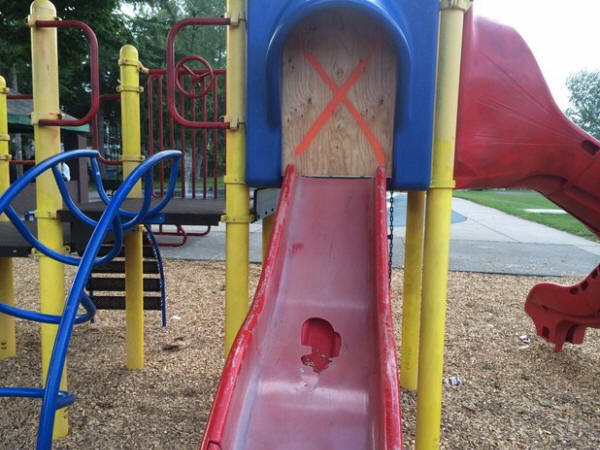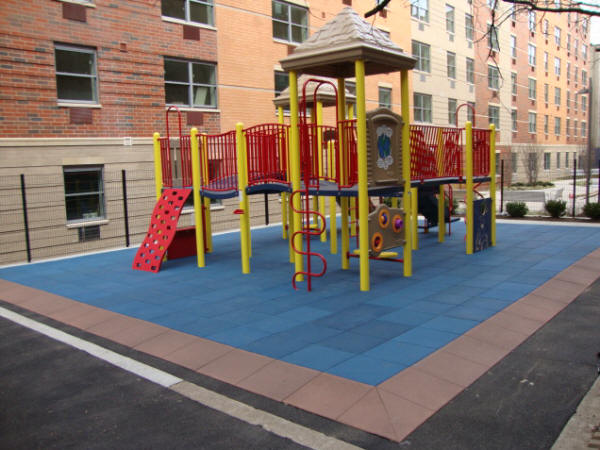Inspectable Item: Play Areas
Notes

The Level 3 definition, however, simply says that play equipment is Level 3 any time it is dangerous due to any kind of hazard.
No specific hazard is named - so, sharp edges, trip hazards, hanging, impalement, and any dangerous condition associated with damage is fair game.
This does not seem to include "bullies."

Look for damage like tears and separated seams in this kind of surface material.
For old school dirt, mulch, and other types of less sophisticated surfaces, just consider this an additional "erosion" defect specifically for the play ground.
| Play Areas and Equipment (Site) |
| An outdoor area set aside for recreation or play, especially one containing equipment such as seesaws and swings. |
| This inspectable item can have the following deficiencies: |
| Damaged/Broken Equipment |
| Deteriorated Play Area Surface |
| Damaged/Broken Equipment (Play Areas and Equipment—Site) |
| Deficiency: Equipment is broken into pieces, shattered, incomplete, or inoperable. |
| Note: Do not evaluate equipment that the POA states have been withdrawn from service, except when safety is still a concern, such as sharp edges, dangerous leaning, etc. For example, if the POA removed the net and hoop from a basketball backboard and the backboard poses no safety hazards, it is not a deficiency. |
| Level of Deficiency: |
| - Level 1: You see that some of the equipment, 20% to 50%, does not operate as it should, but poses no safety risk. |
| - Level 2: You see that most of the equipment, more than 50%, does not operate as it should, but poses no safety risk. |
| - Level 3: You see equipment that poses a threat to safety and could cause injury. |
| Deteriorated Play Area Surface (Play Areas and Equipment—Site) |
| Deficiency: You see damage to a play area surface caused by cracking, heaving, settling, ponding, potholes, loose materials, erosion, rutting, etc. |
| Level of Deficiency: |
| - Level 1: N/A |
| - Level 2: 20% to 50% of the total surveyed play area surface shows deterioration. |
| - Level 3: More than 50% of the surveyed play area surface shows deterioration. |
| Comment: |
| - Level 3: If the play area surface could cause tripping or falling, you must manually record this deficiency under “Hazards (Health and Safety).” |
D. Play Areas and Equipment
1. Inspectors are to inspect park benches located within a play area and record deficiencies as [Site], [Play Areas and Equipment], [nearest associated building], [Play equipment (including benches) is broken, damaged, or inoperable]... Benches not located within a play area are not inspected, unless Health and Safety issues are observed.
p. 29
H. FHEO - Accessible Outside Common Areas
1. This inspectable item applies to all occupied buildings regardless of building type that have areas outside of the building that are commonly used by all residents. Outside common areas include parking lots, patios, play areas, and freestanding and attached common buildings such as a laundry building. When selecting a location in the inspection software use “Other Community Spaces” unless there is a more appropriate location provided.
p. 32
c. All other resident owned property will be inspected for Health and Safety deficiencies only. Health and Safety deficiencies observed on property owned by residents must be recorded as [Health and Safety], [appropriate room location], [Hazards], [Any Other - This Does Pose a Risk of Bodily Injury].
Examples of resident owned property are fire extinguishers, mirrors, picture frames, fan covers, and play equipment.